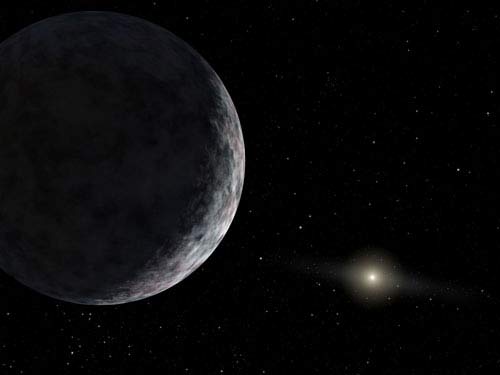Scientists Discover 10th Planet's Moon

LOS ANGELES (AP) -- The astronomers who claim to have discovered the 10th planet in the solar system have another intriguing announcement: It has a moon.
While observing the new, so-called planet from Hawaii last month, a team of astronomers led by Michael Brown of the California Institute of Technology spotted a faint object trailing next to it. Because it was moving, astronomers ruled it was a moon and not a background star, which is stationary.
The moon discovery is important because it can help scientists determine the new planet's mass. In July, Brown announced the discovery of an icy, rocky object larger than Pluto in the Kuiper Belt, a disc of icy bodies beyond Neptune. Brown labeled the object a planet and nicknamed it Xena after the lead character in the former TV series ''Xena: Warrior Princess.'' The moon was nicknamed Gabrielle, after Xena's faithful traveling sidekick.
By determining the moon's distance and orbit around Xena, scientists can calculate how heavy Xena is. For example, the faster a moon goes around a planet, the more massive a planet is.
But the discovery of the moon is not likely to quell debate about what exactly makes a planet. The problem is there is no official definition for a planet and setting standards like size limits potentially invites other objects to take the ''planet'' label.
Possessing a moon is not a criteria of planethood since Mercury and Venus are moonless planets. Brown said he expected to find a moon orbiting Xena because many Kuiper Belt objects are paired with moons.
The newly discovered moon is about 155 miles wide and 60 times fainter than Xena, the farthest-known object in the solar system. It is currently 9 billion miles away from the sun, or about three times Pluto's current distance from the sun.
Breaking space news, the latest updates on rocket launches, skywatching events and more!
Scientists believe Xena's moon was formed when Kuiper Belt objects collided with one another. The Earth's moon formed in a similar way when Earth crashed into an object the size of Mars.
The moon was first spotted by a 10-meter telescope at the W.M. Keck Observatory in Hawaii on Sept. 10. Scientists expect to learn more about the moon's composition during further observations with the Hubble Space Telescope in November.
Brown planned to submit a paper describing the moon discovery to the Astrophysical Journal next week. The International Astronomical Union, a group of scientists responsible for naming planets, is deciding on formal names for Xena and Gabrielle.
Alicia is a former contributing writer for Space.com working in the areas of Space Exploration and Human Spaceflight. She's currently a health and science editor for The Associated Press in New York, where she's been employed since 2017. She's a 2018 Tow-Knight entrepreneurial journalism fellow at the CUNY Graduate School of Journalism and was a 2015–16 Knight Science Journalism fellow at the Massachusetts Institute of Technology.
